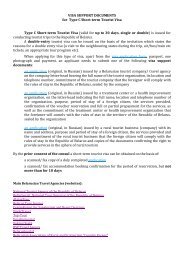Human Development Report 2013 - UNDP
Human Development Report 2013 - UNDP
Human Development Report 2013 - UNDP
You also want an ePaper? Increase the reach of your titles
YUMPU automatically turns print PDFs into web optimized ePapers that Google loves.
<strong>Human</strong> <strong>Development</strong> <strong>Report</strong> <strong>2013</strong>The Rise of the South <strong>Human</strong> Progress in a Diverse WorldPopulationTotal a Annual growth Urban Median age Total dependency ratio Total fertility rate Sex ratio at birth b(millions) (%) (% of total) (years)(per 100 peopleages 15–64)(birthsper woman)(male to female births)HDI rank 2012 2030 2000/2005 2010/2015 a,c 2000 2012 2000 2010 2000 2012 2000 2012 a,c 2000 d 2012 c183 Burkina Faso 17.5 29.1 2.9 3.0 17.8 27.4 16.5 17.1 95.3 90.5 6.3 5.8 1.05 1.05184 Chad 11.8 18.4 3.5 2.6 21.5 21.9 16.9 17.1 96.2 92.6 6.6 5.8 1.03 1.03185 Mozambique 24.5 35.9 2.6 2.2 29.1 31.4 17.9 17.8 88.8 89.1 5.7 4.8 1.03 1.03186 Congo, Democratic Republic of the 69.6 106.0 2.9 2.6 29.3 34.8 16.0 16.7 102.6 94.0 6.9 5.5 1.03 1.03186 Niger 16.6 30.8 3.5 3.5 16.2 18.1 15.8 15.5 102.3 104.8 7.5 7.0 1.05 1.05Other countries or territoriesKorea, Democratic People’s Rep. of 24.6 26.2 0.7 0.4 59.4 60.4 29.9 32.9 49.5 47.0 2.1 2.0 1.05 1.05Marshall Islands 0.1 0.1 0.0 1.6 68.4 72.2 .. .. .. .. .. .. .. ..Monaco 0.0 0.0 0.1 0.0 100.0 100.0 .. .. .. .. .. .. .. ..Nauru 0.0 0.0 0.1 0.6 100.0 100.0 .. .. .. .. .. .. .. ..San Marino 0.0 0.0 2.3 0.6 93.4 94.1 .. .. .. .. .. .. .. ..Somalia 9.8 16.4 2.4 2.6 33.2 38.2 18.0 17.5 88.3 91.0 6.5 6.3 1.03 1.03South Sudan 10.7 16.1 2.8 l 3.2 l 16.5 18.2 .. .. .. .. .. .. .. ..Tuvalu 0.0 0.0 0.6 0.2 46.0 51.0 .. .. .. .. .. .. .. ..<strong>Human</strong> <strong>Development</strong> Index groupsVery high human development 1,134.3 1,216.9 0.7 0.5 77.0 81.2 36.8 39.3 49.1 50.3 1.6 1.8 1.05 1.06High human development 1,039.2 1,150.1 0.9 0.8 70.1 74.1 27.6 30.4 54.7 46.4 2.2 1.9 1.05 1.05Medium human development 3,520.5 4,017.4 1.2 1.0 34.8 43.7 25.6 28.9 56.8 47.0 2.5 2.1 1.10 1.10Low human development 1,280.7 1,845.3 2.3 2.2 28.6 33.6 18.4 19.8 85.2 75.5 5.1 4.2 1.04 1.04RegionsArab States 357.3 480.8 2.2 2.0 53.2 57.2 20.6 23.3 72.3 59.7 3.9 3.0 1.05 1.05East Asia and the Pacific 1,991.4 2,135.3 0.8 0.6 36.7 49.7 28.1 32.3 50.8 40.9 2.0 1.8 1.14 1.12Europe and Central Asia 481.6 491.3 0.0 0.2 63.2 64.8 32.9 34.9 49.5 43.4 1.6 1.7 1.06 1.06Latin America and the Caribbean 597.7 696.0 1.3 1.1 75.3 79.3 24.4 27.5 60.3 52.1 2.6 2.2 1.05 1.05South Asia 1,753.0 2,141.8 1.6 1.4 29.0 32.9 22.0 24.6 66.7 54.6 3.3 2.6 1.07 1.07Sub-Saharan Africa 852.5 1,284.0 2.5 2.5 32.0 37.0 17.8 18.5 88.6 83.4 5.6 4.8 1.04 1.04Least developed countries 870.4 T 1,256.8 T 2.2 T 2.2 T 24.3 T 28.9 T 18.3 T 19.7 T 85.5 T 75.5 T 5.1 T 4.1 T 1.04 T 1.04 TSmall island developing states 53.8 63.8 1.3 1.1 48.2 52.6 24.0 26.6 64.6 57.3 3.1 2.7 1.06 1.06World 7,052.1 T 8,321.3 T 1.2 T 1.2 T 46.7 T 52.6 T 26.7 T 29.2 T 59.0 T 52.0 T 2.7 T 2.5 T 1.07 T 1.07 TNOTESa Projections based on medium-fertility variant.b The natural sex ratio at birth is commonlyassumed and empirically confirmed to be 105male births to 100 female births.c Data are annual average of projected values for2010–2015.d Data are average annual estimates for2000–2005.e Includes Svalbard and Jan Mayen Islands.f Includes Christmas Island, Cocos (Keeling) Islandsand Norfolk Island.g Includes Canary Islands, Ceuta and Melilla.h Includes Kosovo.i Includes Taiwan, China, and excludes Hong KongSpecial Administrative Region and Macao SpecialAdministrative Region.j Excludes Hong Kong Special AdministrativeRegion and Macao Special Administrative Region.k Estimates are for Sudan only and do not includeSouth Sudan.l HDRO calculations based on population data fromUNDESA (2012b).T Aggregate from original data source.DEFINITIONSPopulation: De facto population in a country, areaor region as of 1 July.Annual population growth rate: Average annualexponential growth rate for the period specified.Urban population: De facto population living inareas classified as urban according to the criteriaused by each area or country as of 1 July.Median age: Age that divides the populationdistribution into two equal parts—that is, 50% of thepopulation is above that age and 50% is below it.Total dependency ratio: Ratio of the sum of thepopulation ages 0–14 and ages 65 and older to thepopulation ages 15–64.Total fertility rate: Number of children that wouldbe born to each woman if she were to live to theend of her child-bearing years and bear children ateach age in accordance with prevailing age-specificfertility rates.Sex ratio at birth: Number of male births perfemale birth.MAIN DATA SOURCESColumns 1, 2, 13 and 14: UNDESA (2012b).Columns 3, 4 and 7–12: UNDESA (2011).Columns 5 and 6: UNDESA (2012a).Table 14 Population trends | 197
















